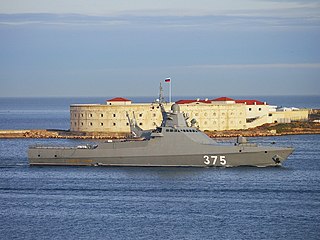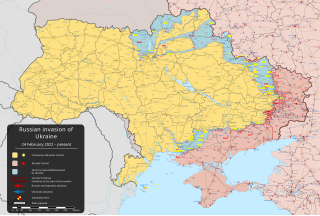
The Tarantul-class corvette, Soviet designation Project 1241 Molniya are a class of Russian missile corvettes.

The Black Sea Fleet is the fleet of the Russian Navy in the Black Sea, the Sea of Azov and the Mediterranean Sea. The Black Sea Fleet, along with other Russian ground and air forces on the Crimean Peninsula, are subordinate to the Southern Military District of the Russian Armed Forces.

The Ukrainian Navy is the maritime forces of Ukraine and one of the five branches of the Armed Forces of Ukraine.

Stridsbåt 90 H(alv) is a class of fast military assault craft used by several countries after being originally developed for the Swedish Navy by Dockstavarvet. Its name means Combat Boat 90 Half; the 90 refers to the year of acceptance (1990) and Half refers to the fact that it can carry and deploy a half platoon of amphibious infantry fully equipped. The CB90 is an exceptionally fast and agile boat that can execute extremely sharp turns at high speed, decelerate from top speed to a full stop in 2.5 boat lengths, and adjust both its pitch and roll angle while under way. Its light weight, shallow draught, and twin water jets allow it to operate at speeds of up to 40 knots (74 km/h) in shallow coastal waters. The water jets are partially ducted, which, along with underwater control surfaces similar to a submarine's diving planes, gives the CB90 its manoeuvrability.

The Zubr class, Soviet designation Project 1232.2, is a class of Soviet-designed air-cushioned landing craft (LCAC). The name "Zubr" is Russian for the European bison. This class of military hovercraft is, as of 2023 the world's largest hovercraft, with a standard full load displacement of 555 tons. The hovercraft was designed to sealift amphibious assault units from equipped/non-equipped vessels to non-equipped shores, as well as to transport and plant naval mines.

The Ropucha class, Soviet designation Project 775, is a class of landing ship built in Poland for the Soviet Navy. The ships were built in the Stocznia Północna shipyards in Gdańsk, Poland. They were designed for beach landings, and can carry 450 tons of cargo. The ships have both bow and stern doors for loading and unloading vehicles, and the 630 square metres (6,800 sq ft) of vehicle deck stretch the length of the hull. Up to 25 armored personnel carriers can be embarked.

Tapir-class landing ship, Soviet designation Project 1171 landing ship is a class of Soviet/Russian general purpose, beachable amphibious warfare ships.

The Dyugon-class landing craft, Russian designation Project 21820, is a class of five air-cavity landing craft in service with the Russian Navy.

The Ondatra class Soviet designation Project 1176 Akula ("shark") is a class of landing craft built for the Soviet Navy and Russian Navy between 1971 and 2009.
Air cavity system is a modern marine hull design concept based upon capturing air beneath a vessel's hull to reduce drag and increase speed and fuel efficiency.

Project 22160 is a series of large patrol ships being constructed for the Russian Navy. The vessels are primarily intended for duties such as patrol, monitoring and protection in open and closed seas. The first ship was laid down in February 2014 and joined the Russian Navy in December 2018. By January 2018, six ships were under construction. Between 2017 and 2022, four ships had been launched.

The Project 58155 Gyurza-M class is a series of small armored gunboats in service with the Ukrainian Navy. The first two vessels were laid down at the Kuznia na Rybalskomu shipbuilding plant in October 2012. Originally it was planned to build nine such vessels by 2017. In December 2013 the Ministry of Defence withdrew its contract. The class is named after the Levant viper, Гюрза, Hiurza, in Ukrainian.

The Project 58181 Centaur (Kentavr)/Project 58503 Centaur-LK class is a series of small armored assault craft being built for the Ukrainian Navy. The first two vessels were laid down at the Kuznya na Rybalskomu in December 2016. The 58181 project was developed by State Research and Design Shipbuilding Center on the basis of the Gyurza-M-class gunboats, and the 58503 project number was assigned to the altered design used after construction of the first eight units began (by the contractor that oversaw their construction, PJSC ZLK. Designed for carrying patrol service on rivers and coastal maritime areas, delivery and landing of marines.

The Raptor-class patrol boat, Russian designation Project 03160, is a series of Russian high-speed coastal patrol boats. Boats of the class belong to the 4th rank ships in the Russian Navy. This project was developed by the design bureau of JSC Leningrad Shipyard Pella on the instructions of the Russian Navy. The boats are built at the Pella shipyard in the town of Otradnoye, Leningrad Region. Due to the great similarity in appearance, the boats of the project can be confused with the Swedish CB90-class fast assault craft and other transport and landing boats of the 02510 BK-16 project, developed by the Kalashnikov concern and manufactured at Rybinsk shipyard.
The Snake Island campaign was a period of Russian occupation and military conflict for Snake Island, a small, strategically located Ukrainian island in the Black Sea. On 24 February 2022, the first day of the Russian invasion of Ukraine, the Russian Navy attacked Snake Island and captured it along with its entire garrison, beginning a military occupation of the island. The attack was widely publicized when an audio clip of the Russian cruiser Moskva hailing the island's garrison over the radio demanding their surrender and being told "Russian warship, go fuck yourself" in response went viral, along with initial inaccurate reports of the garrison's deaths. Later on, it emerged that a civilian search and rescue ship trying to evacuate the soldiers was also captured along with the garrison. The ship, its crew, and at least one soldier were subsequently freed in prisoner exchanges.

Beginning in July 2022, a series of explosions and fires occurred on the Russian-occupied Crimean Peninsula from where the Russian Army had launched its offensive on Southern Ukraine during the Russian invasion of Ukraine. Occupied since 2014, Crimea was a base for the subsequent Russian occupation of Kherson Oblast and Russian occupation of Zaporizhzhia Oblast. The Ukrainian government has not accepted responsibility for all of the attacks.
MAGURA V5 is a Ukrainian multi-purpose unmanned surface vehicle (USV) developed for use by the Main Directorate of Intelligence of Ukraine (GUR) capable of performing various tasks: surveillance, reconnaissance, patrolling, search and rescue, mine countermeasures, maritime security, and combat missions.

Naval warfare in the Russian invasion of Ukraine began on 24 February 2022, when the Russian Armed Forces launched a full-scale invasion of Ukraine, in a major escalation of the Russo-Ukrainian War, which began in 2014. Media reporting of and focus on the invasion has largely been on the terrestrial and aerial aspects – however, maritime engagements have been consequential during the conflict. Disputes over Ukrainian grain exports through the Black Sea have also played a significant role.















